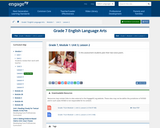
In this assessment students plan their two-voice poem.
- Subject:
- English Language Arts
- Material Type:
- Unit of Study
- Provider:
- EngageNY
- Author:
- Expeditionary Learning
- Date Added:
- 04/04/2014

In this assessment students plan their two-voice poem.

In this lesson students read a model poem focusing on how the author of the poem used evidence.

The Researching to Deepen Understanding units lay out an inquiry process through which students learn how to deepen their understanding of topics. Students pose and refine inquiry questions, exploring areas they wish to investigate. They find and assess sources and organize researched material in ways that will support their analysis and integration of information.

In this CCSS lesson, students will explore this story through text dependent questions, academic vocabulary, and writing assignments.

This webpage contains theme-based discussion prompts for each vignette in The House on Mango Street by Sandra Cisneros, as well as a selection of follow-up activities.

In this lesson, students apply their understanding of the point of view of a literary work and how it affects the story line through writing their own family position paragraphs.

In this video resource from PBS Learning Media, students will explore the types of humor that exist, such as Irony, Satire, Farce, and Parody. They will research and find examples of humor that appeal to them. Next, they will choose a passage written by Mark Twain and analyze it to determine what type of humor is used.

This lesson will use the "infinite variety" of resources on the Internet to let students find their own image of Othello. The lesson will take them on a WebQuest, first to textual references, and then to on-line searches for images of Othello in film, play productions, and art. Then, students will write an essay about the casting of Othello to conclude the lesson.

This autobiographical piece tells what a neat, tidy rule-follower this author was in his youth—except for his yo-yo. In this CCSS lesson, students will explore this story through text dependent questions, academic vocabulary, and writing assignments.

Students will read a description of and passage from a work by Louisa May Alcott, events, questions, vocabulary, definitions, text examples, and a writing prompt. Students will write short answers, ideas to support a main idea, and an essay. This resource supports English language development for English language learners.

Students will read a description of and passage from Lewis Carroll's work, events, questions, vocabulary, definitions, text excerpts, and a writing prompt. Students will write short answers, quotations to support a main idea, and an essay. This resource supports English language development for English language learners.

In this lesson, students are introduced to the performance task for the module, a two voice poem.

In this lesson, students will analyze point of view by considering how comparing and contrasting Salva and Nya's experiences allows the author to show what factors enabled survival in Sudan.

In this lesson, students will plan their two-voice poem, focusing on the juxtaposition of characters and how they convey ideas about survival in Sudan.

In this lesson, students will continue to practice "getting the gist" through continued use of Reader's Notes and an additional discussion activity. This lesson will help prepare students for the upcoming shift in focus to the guiding question for the unit and enhance their skill sin gathering and analyzing evidence from the text.

In this lesson, students will read a model poem, focusing on how the author of the poem used evidence.

In this lesson, students will be introduced to a guiding question that will help focus their work. Students will gather evidence about Salva's and Nya's points of view.

In this lesson, students will be introduced to the concept of juxtaposition in A Long Walk to Water.

In this lesson, students will use a specific, selected response question in order to gather and use evidence to analyze Savla's and Nya's points of view.

In this lesson, students will use a text based discussion protocol to analyze theme and characters in the novel.